#I demonstratively put them in a soviet bus
Explore tagged Tumblr posts
Text

Modern AU but Theon got kicked out of the Starks' house at 18 (because Catelyn just couldn't deal with him anymore and he was probably spreading his bad influence all over the children), got kicked out of the Greyjoy residence (because Balon disowned Euron a month before that so might as well get the other headache away from here), and is now living in a village in the middle of the Northern nowhere with two prostitutes (Kyra and Ros, who took him in because he's the only one that can cook with more than two ingredients (eggs and pan)) in a property given to them by Littlefinger in exchange for tax-free stweardship. And they go out into the city every day on a bus numbered 47 that passes by the village only at 6am and 6pm only on workdays for Theon to try and find work and stop freeloading and maybe go to university one day but the only place that is willing to hire him is the Butchers' round the corner (Theon would've gotten over the bad work conditions and the mould on the walls if it weren't for the fact that the Butcher keeps looking at him with his weird ass pale blue eyes like he wants to snap his spine and eat his pith every time he passes)
#I love these stream of of consciousness modern aus#mine isn't as wild but that's because I'm not actually promoting the modern au agenda#I'm promoting my “the Iron Islands are the Balkans and the North is Eastern Europe” agenda#I demonstratively put them in a soviet bus#asoif/got#asoif fanart#asoiaf#game of thrones#theon greyjoy#got ros#asoiaf ros#asoiaf kyra#ramsay bolton#ramsay snow
240 notes
·
View notes
Text
Day 48, 7th Oct, Berlin
This morning I caught a bus around the corner from my hotel. I buy a day card each day, which costs about €7, and it lets you travel on any form of transport all over the city, so great value. Bus 265 took me to where I was going. This bus continues on to Tempelhof Park which is where the huge impressive Russian Memorial is located but I didn’t have time to revisit that today. On the street I came across some more ‘stumbling stones’. These people died in Auschwitz and Chelmno.
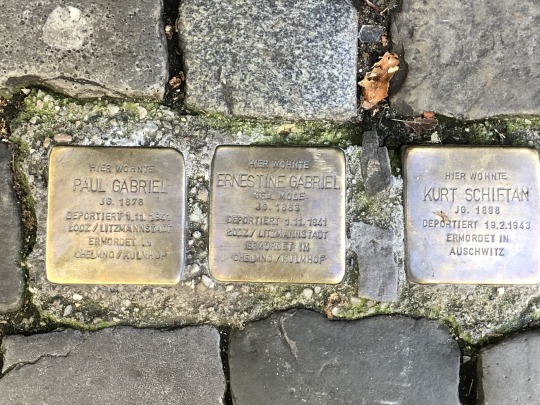
This was the building the stones were in front of. The stones are a real reminder of what happened on this spot during the war.
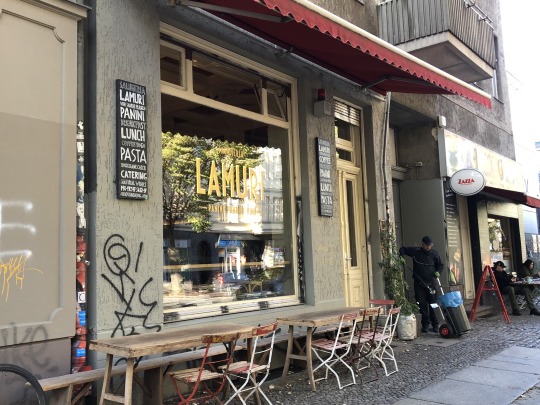
I was in this location as I wanted to see this particular street art painted by the identical Brazilian twins Otavio and Gustavo Pandolfo who are best known for their large-scale installations and murals depicting strangely dressed and unusually proportioned, yellow-skinned figures. Influenced primarily by their upbringing in São Paolo, they first started developing their recognizable style at the age of twelve. I have now seen their work in Łódź, Vilnius, Lisbon, Vancouver and now Berlin.

The U Bahn also rans through this area up on raised lines. I was on my way to the East Side Gallery across the river after seeing the painting.
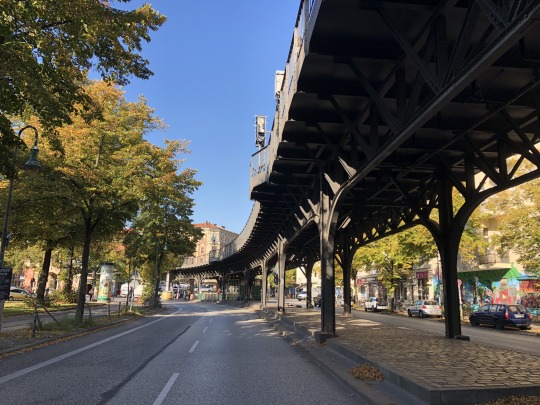
The Oberbeurn Bridge which is considered one of the most attractive bridges in Germany. The towers were badly damaged in the war. The bridge was one of the dividing lines between east and west. The bridge in East territory.
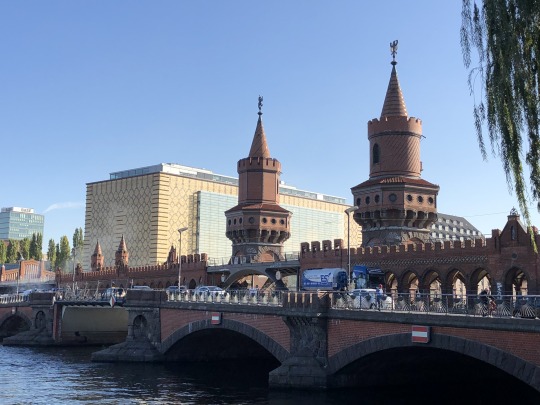
The river was in East Berlin, as well.

The East West Gallery runs along the river in this area. The birth of Berlin’s street art scene can be traced back to 1961 when the Soviet Union erected the Berlin wall, separating East Germany from West Germany. Due to the symbolic significance of the wall as a divisive medium, it became the obvious place for the citizens of Berlin to express their opinions and frustrations on a whole range of issues. On the other hand, it was also seen as an exceptionally unattractive eyesore that the people of Berlin felt compelled to do something about. During the Cold War, the West side of the Berlin wall was completely covered in painting, unlike the East side of the wall which remained blank, because people in East Berlin were unable to get close enough to the wall to paint on it. Interestingly, since the wall fell in 1989, a lot of new art was added to the East side of wall in the 1990’s, allowing viewers to trace the historical and political change that occurred in Europe by comparing and contrasting the different themes depicted on either side of the wall.

The paintings seemed a bit different to when I was here before. I know there has been some work done to preserve the almost 30 year old paintings in some cases but there looked to be new ones and not all about the wall.

This one is probably the most iconic. It has definitely been given a facelift. It’s of Breszhnev kissing Honecker.
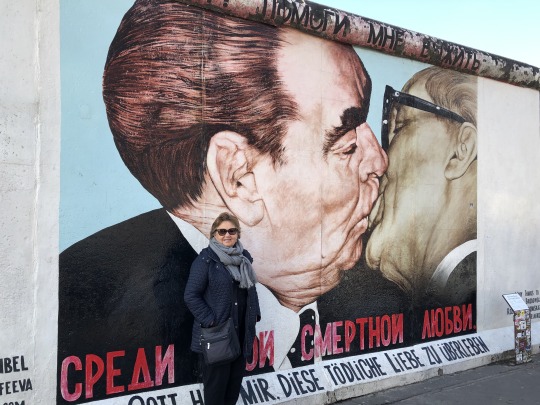
Some that I remembered from last time were a bit hard to see as there was a new building going up and boards were in place along part of the wall.
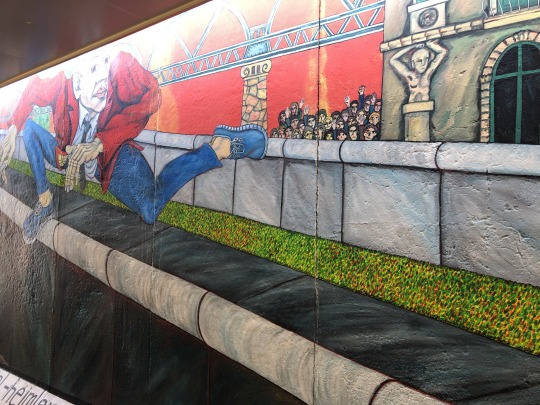
Mercedes Benz dominates the city a bit. The company brings in a lot of money as well as owning a lot if real estate. The areana is across the road from the Gallery.

New work like this one was about Amestry International.

From the Gallery I caught a U Bahn then the No. 100 bus that goes from Alexander Platz up the main strip to the Brandenburg Gate. The statues on the River Spree.
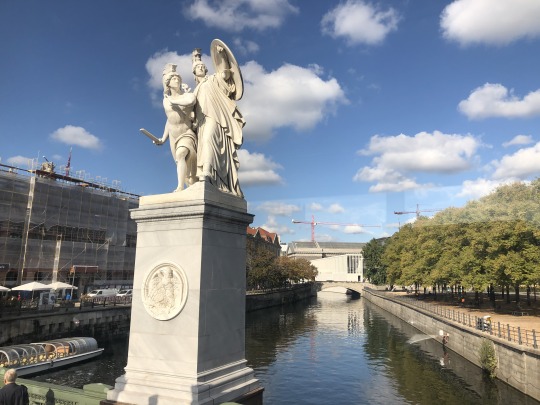
One of the Museums in this area.

The Dom.

The University.
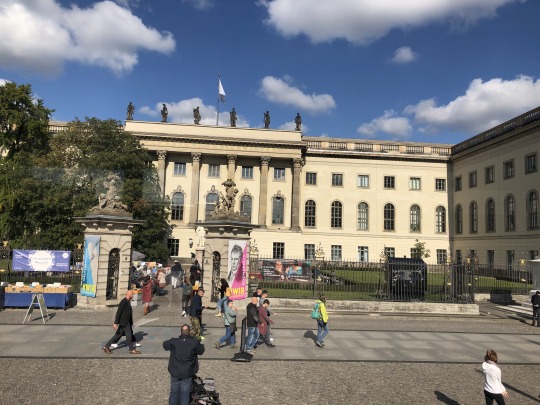
The Brandenburg Gate.
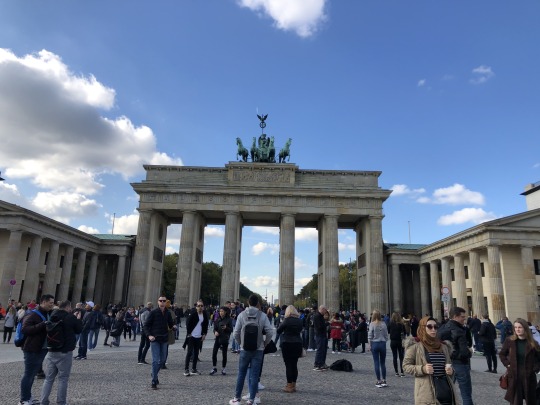
Very close to the Brandenburg Gate is the Jewish Memorial.

It’s just all grey blocks of different heights and sizes on undulating land. Very unique.

From the Memorial I walked to the Sony Centre at Potsdam Platz. I had never seen it close up.

Quite spectacular the space inside.

The roof is amazing. I spent a bit of time in here.

Back on the streets a climate change demonstration was going on. All very peaceful.

Mostly young people there with a big police presence.

All over Berlin you come across information boards about some historical event in the past. The Germans don’t hide their history.

These cars where used extensively in East Berlin and are now a novelty. You can hire them for a ride around the city.

This is part of the wall at the Topography of Terror.

The ballon was taking people up high for a birds eye view.
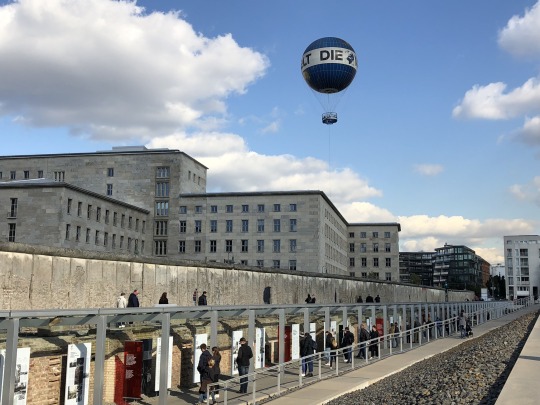
Wherever the Wall was in Berlin it is now indicated by stone work and bronze plaques.

Checkpoint Charlie.
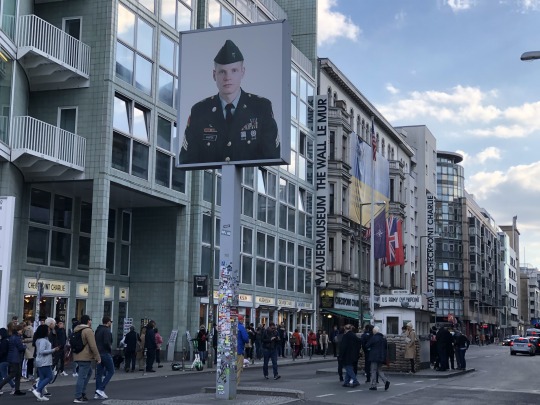
I took the opportunity to have my photo taken. Usually there are people dressed in Us and Russian uniforms you pay to have your photo with. Maybe they have stopped that.
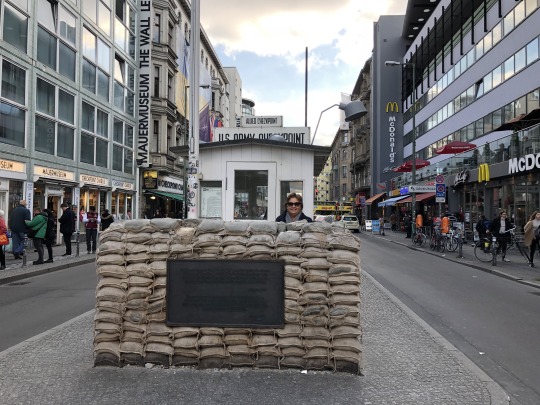
This is the way it looked in the day. A very tense location.
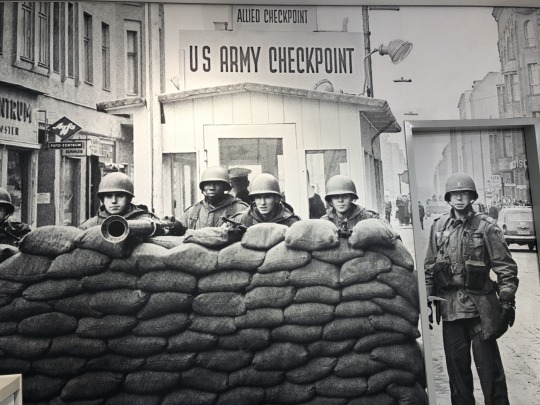
The sign at Checkpoint Charlie.

This girl had an interesting tale. I came across her putting down a row of dirt and a row of seeds. It symbolises the joining together and growth that comes when things combine. Eg seeds and dirt. She is an artist and tries to do 9 each day. I can’t remember how many she wants to do all up but it’s between her parents home and the refugee camp they were in when they arrived in Berlin from Russia. She was 9 when they came in 1995. She told all about her family and that she doesn’t know whether she feels a Russian or German. A common issue for many new migrants. It’s amazing what you come across walking the streets.

I finally made it to the Jewish Museum. I have never been there before. The front of the Museum is very different from the newer building that houses most of the exhibits.
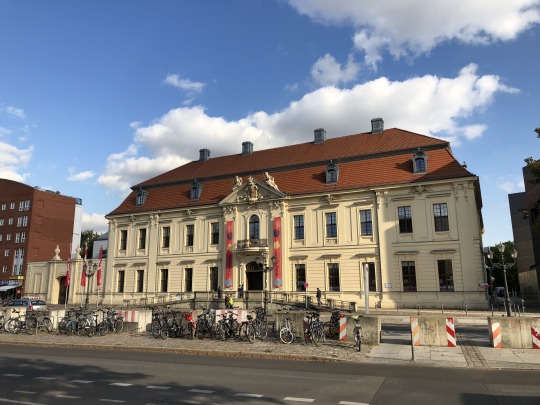
The Halocaust Tower.

Slanting walls, sharp angles, gaping voids. The architecture creates its own symbolic language for the history of the Jews in Germany. The Axis of the Halocaust and The Axis of Exile portray the persecution and murder of Jews during the Nazi era, as well as the escape from Germany into exile.

The Garden of Exile is made up of 49 concrete slabs positioned on sloping ground. The trees growing on top are a symbol of hope.

The Memory Void is dedicated to the victims of war. 10,000 heavy iron plates are cut to resemble faces. You can walk on the faces and they give off a clanging sound which is a bit chilling.

The grey futuristic look of the new building which houses most of the museum.

A lighter exhibition of photographs from the West Bank of Isreal was also in the museum.

Some great photos.

The lights in the cafe had Hebrew written inside which made a great pattern with its reflection.

From the museum I could catch the No 248 bus back to the hotel but I went further to Alexander Platz for another look around and then the bus back. Another long interesting day. Heading north again tomorrow on the train.
6 notes
·
View notes
Photo

Natalie Jones and the Golden Ship
Part 1/? - A Meeting at the Palace Part 2/? - Curry Talk Part 3/? - Princess Sitamun Part 4/? - Not At Rest Part 5/? - Dead Men Tell no Tales Part 6/? - Sitamun Rises Again Part 7/? - The Curse of Madame Desrosiers Part 8/? - Sabotage at Guedelon Part 9/? - A Miracle Part 10/? - Desrosiers’ Elixir Part 11/? - Athens in October
Paris in the spring, it ain’t.
It had been cold and wet in England, and damp and chilly in France. When the plane landed in Athens, Natasha was prepared for it to be warmer – but walking onto the jetway was like walking into a sauna. It was only about twenty degrees Celcius, but there was not a cloud in the sky and the air was thick with Mediterranean moisture.
“How did you like your first aeroplane flight?” Sharon asked Sir Stephen, as they picked up their luggage. Months earlier, while they’d waited for night to fall in Sherwood Forest, she had pointed out an airplane and suggested that Sir Stephen might get to ride in one someday. Nat suspected it had been on both their minds all day.
“It was a bit of a disappointment,” said Sir Stephen. “The interior is so enclosed and the windows so small, you can barely tell you’re in the air. I liked the train much better. You could see the countryside you were travelling through.”
“It’s not for sightseeing,” Sam agreed. “Just for getting where you’re going.”
“If you’re in a hurry I suppose it’s fine,” Sir Stephen said with a shrug. “You couldn’t do it for a pilgrimage, certainly.”
“Why not?” said Nat. “Thousands of people go by air for pilgrimages every year. It’s the only way Muslims overseas can get to Mecca.”
Sir Stephen was startled. “But the point of a pilgrimage is to make a journey,” he protested. “People who live in Compostela do not walk up the street to see the relics of Saint James and call it a pilgrimage. Pilgrims are demonstrating to God that they are willing to undergo hardship. To simply fly over all obstacles in your way makes it seem so trivial.”
“Next time we’ll let you pay for the tickets,” Clint said. “Then we’ll see if you still call it trivial.”
Outside in the parking lot, they met the bus that would take them to their hotel, and everybody was pleased to find that it was air conditioned. The landscape between airport and city was a wide desert valley, with hazy hills visible all around the border of it. Life hadn’t changed much here in thousands of years – it was still all stony red soil and tiny farms, though in the twenty-first century these were as likely to host rows of solar panels as lines of olive trees. The buildings had white walls and red tile roofs, and sheep and goats grazed on little lots of pasture. It really did look, Nat observed, like something out of another time.
“How are we going to find Madame Desrosiers?” asked Allen.
“By talking to people,” Natasha replied. “Expats in areas like this, warm places where people like to retire, tend to live in close-knit communities. So we’ll have to find where the French people live, and ask around.”
“Oh,” said Allen.
Nat glanced at him. “You sound disappointed,” she observed.
“I am a little,” he admitted. “I was sort of hoping there was some special technique spies use.”
“Sorry!” said Nat with an amused smile. “Sometimes good old-fashioned legwork is best.”
“Absolutely,” Sharon agreed. “Even nowadays, when we have CCTV cameras all over the country and DNA evidence, most of what a detective does is talk to people.”
“But if we’re in Athens,” Nat added, “you guys will probably want to let me do the actual talking. Possibly Allen, too – none of the rest of you.”
Sam, Sharon, and Clint all nodded knowingly, but Sir Stephen was confused. “Why?” he asked.
“Because they’re the Americans, Steve,” said Sharon. “Greeks don’t like British people, and they’ll like us even less now that we’ve at least tried to give Princess Sitamun back to Egypt.”
“Why not?” Sir Stephen wanted to know.
“The Elgin Marbles,” said Natasha. “Once we find Desrosiers, we can go see the reproductions in the Acropolis Museum, and I’ll tell you about it.”
Athens itself was a maze of little roads between somewhat shabby-looking buildings, with tiny European cars and motorcycles zipping along with little regard for pedestrians or each other. The entrance to their hotel, located just a few minutes from the ancient acropolis, was a narrow door in between a pharmacist’s and a camera shop – Sharon and Sir Stephen checked them in at the front desk, while the rest of them took turns hauling their luggage to the fourth floor, in an elevator that claimed to be rated for the weight of nine people but didn’t look big enough to even hold three. Once they had their rooms, they immediately turned on the air conditioning again, and since they’d had a series of very long days, they all went to bed early.
Nat was sharing a room with Allen. As she was getting her nightshirt on, she heard him say around his toothbrush, “I didn’t know Sir Isaac Newton was an alchemist.”
“A lot of people don’t,” said Natasha. “His alchemical writings were only discovered in the 1930’s, but there’s loads of them. He was apparently much more interested in magic and theology than he was in science and math, he just didn’t publish what he wrote.”
“I wonder why not,” said Allen.
Nat knew the answer to that. “Partly because alchemy was illegal in England in the seventeenth century, because the crown was tired of con men who promised to make gold but then took your gold and disappeared. And Newton’s theological writings would have gotten him in trouble with the Church of England. He denied the divinity of Christ, which was a heresy punishable by death.”
Allen spit out his mouthful of toothpaste. “That would explain it,” he said with a chuckle. “How do you possibly remember all this stuff?”
“I was trained to remember everything I read,” Nat explained, “and most of what I hear, if I’m paying attention. Did you know that quail meat can be toxic if eaten at the wrong time of year, because the birds eat poisonous plants? Or that a churango is a musical instrument made out of a dead armadillo?”
“No, I didn’t know any of that,” said Allen, standing in the bathroom doorway with a fond smile on his face. “But I bet I won’t forget it. You know who you sound like?”
“Who?” Nat asked, pulling out her own toiletries.
“My daughter,” he said gently. “In my memories you were always full of stuff you’d learned and wanted to share. You’d learn something new in ballet class and come home and show it to us. Or you’d tell us what you learned in school that day – with your mouth full, when you were little. Your Mom and I used to have to remind you to swallow first.”
Natasha could picture it – herself as a child, sitting there eating spaghetti while excitedly telling her family about… about what? She had brought news home when she was small, but it wasn’t about her ballet classes.
“You’re upset now,” Allen observed.
“No, I’m fine,” Natasha said quickly and automatically.
Allen came and put his hands on her shoulders. “No, I’ve upset you. I can tell.”
She sighed and stepped away, hugging her own shoulders, then forced herself to give him a watery smile. “It’s just that your version sounds way nicer than the real… than the one I remember.”
“Do you want to tell me about it?” he asked.
Natasha knew he was asking because he cared. He wanted to help her bear the weight of the memories, because that was what families did.
She sat down on the bed. “When I was little, in training, my masters at the Red Room would plant us in groups of schoolchildren who were touring government buildings or newspaper offices… places like that. Our job was to ‘get lost’ and wander around listening to conversations among people who were suspected of political dissent. It was towards the end of the Soviet Union, of course, but there were lengths people weren’t allowed to go to, and the Red Room was much more hardline than the government was. I wonder sometimes, whether anybody ever got executed because of something I told my instructors when I got back. Probably not,” she added quickly. “Considering the times.”
Who was she reassuring, she wondered – Allen, or herself?
He didn’t reply right away, and Natasha wanted to look up at his face but didn’t dare. She couldn’t bear to find out what he was thinking. A moment ago he’d shared that warm memory of his little daughter chatting about what she’d learned at school, and now she’d stained it with eavesdropping and possible murder.
“Even if they were, it wasn’t your fault,” said Allen. He sat down beside her and put an arm around her shoulders. “You were a child. You didn’t know what you were doing.”
“Yes I did,” said Nat. “They told us – they gave us a list of things to listen for, and told us that people who said them were enemies of the State, our enemies, and we’d be making the world a better place by reporting them so that they could be removed. And we knew what removed meant, because we’d seen it ourselves.”
Again, there was a silence. This time, Natasha forced herself to look up and read Allen’s face. Their room had two beds – they were sitting on the one by the window. The window itself was closed to let the air conditioner do its job, but the curtains were open, and it was possible to see traffic moving on the street outside. Allen was staring thoughtfully out the window at the darkening sky, trying to decide what to say. It only took a few seconds before Nat couldn’t stand it anymore.
“Allen?” she asked. It was not a moment to call him Dad.
He looked at her and ran his hand up and down her back. “Archaeology,” he said.
“What?” Nat asked.
“Archaeology,” he said. “You dig up the truth and share it.”
A chill washed over Natasha. She’d done a lot of examination in the past few months of why she’d chosen archaeology as her cover. There was the ostensibly practical reason that she was unlikely to become famous for it – the silly but sentimental one that she’d always enjoyed adventure movies – and the one she’d come up with as potential real reason, that after so long living in the shadows she wanted to be responsible for bringing things into the light. She hadn’t thought of it that way, that it was just another way of doing what she’d always done.
“Natasha?” asked Allen.
She swallowed. “It is, isn’t it?” she asked. “I expose people’s dirty secrets and tell them to the world.”
“But it’s different now,” Allen added, “because the people who kept those secrets died a long time ago, and nobody’s going to get hurt because you told.”
“I guess,” said Natasha.
Allen patted her back again. “Was that so hard, Ginger Snap?”
That was what he’d wanted from her, wasn’t it? That she trust him with her past and let him try to help her with it. She’d done her best and he had too, but now that seed of self-doubt had been planted, and she wasn’t sure it wouldn’t do more harm than good in the long run.
“I don’t know,” she said, and she really didn’t.
3 notes
·
View notes
Text
Events 12.11
220 – Emperor Xian of Han is forced to abdicate the throne by Cao Cao 's son Cao Pi, ending the Han dynasty. 361 – Julian enters Constantinople as sole Emperor of the Roman Empire. 861 – Assassination of the Abbasid caliph al-Mutawakkil by the Turkish guard, who raise al-Muntasir to the throne. Start of the "Anarchy at Samarra". 969 – Byzantine Emperor Nikephoros II Phokas is assassinated by his wife Theophano and her lover, the later Emperor John I Tzimiskes. 1282 – Battle of Orewin Bridge: Llywelyn ap Gruffudd, the last native Prince of Wales, is killed at Cilmeri, near Builth Wells, in mid-Wales. 1602 – A surprise attack by forces under the command of Charles Emmanuel I, Duke of Savoy, and his brother-in-law, Philip III of Spain, is repelled by the citizens of Geneva. (Commemorated annually by the Fête de l'Escalade.) 1675 – Antonio de Vea expedition enters San Rafael Lake in western Patagonia. 1688 – Glorious Revolution: James II of England, while trying to flee to France, throws the Great Seal of the Realm into the River Thames. 1792 – French Revolution: King Louis XVI of France is put on trial for treason by the National Convention. 1815 – The U.S. Senate creates a select committee on finance and a uniform national currency, predecessor of the United States Senate Committee on Finance. 1816 – Indiana becomes the 19th U.S. state. 1868 – Paraguayan War: Brazilian troops defeat Paraguayan at the Battle of Avay. 1899 – Second Boer War: In the Battle of Magersfontein the Boers commanded by general Piet Cronjé inflict a defeat on the forces of the British Empire commanded by Lord Methuen trying to relieve the Siege of Kimberley. 1905 – A workers' uprising occurs in Kyiv, Ukraine (then part of the Russian Empire), and establishes the Shuliavka Republic. 1907 – The New Zealand Parliament Buildings are almost completely destroyed by fire. 1917 – World War I: British General Edmund Allenby enters Jerusalem on foot and declares martial law. 1920 – Irish War of Independence: In retaliation for a recent IRA ambush, British forces burn and loot numerous buildings in Cork city. Many civilians report being beaten, shot at, robbed and verbally abused by British forces. 1925 – Roman Catholic papal encyclical Quas primas introduces the Feast of Christ the King. 1927 – Guangzhou Uprising: Communist Red Guards launch an uprising in Guangzhou, China, taking over most of the city and announcing the formation of a Guangzhou Soviet. 1931 – Statute of Westminster 1931: The British Parliament establishes legislative equality between the UK and the Dominions of the Commonwealth—Australia, Canada, Newfoundland, New Zealand, South Africa, and Ireland. 1934 – Bill Wilson, co-founder of Alcoholics Anonymous, takes his last drink and enters treatment for the final time. 1936 – Abdication Crisis: Edward VIII's abdication as King of the United Kingdom and the British Dominions beyond the Seas, and Emperor of India, becomes effective. 1937 – Second Italo-Ethiopian War: Italy leaves the League of Nations. 1941 – World War II: Germany and Italy declare war on the United States, following the Americans' declaration of war on the Empire of Japan in the wake of the attack on Pearl Harbor. The United States, in turn, declares war on them. 1941 – World War II: Poland declares war on the Empire of Japan. 1941 – World War II: The Imperial Japanese Navy suffers its first loss of surface vessels during the Battle of Wake Island. 1946 – The United Nations International Children's Emergency Fund (UNICEF) is established. 1948 – Arab–Israeli War: The United Nations passes General Assembly Resolution 194, creating a Conciliation Commission to mediate the conflict. 1958 – French Upper Volta and French Dahomey gain self-government from France, becoming the Republic of Upper Volta (now Burkina Faso) and the Republic of Dahomey (now Benin), respectively, and joining the French Community. 1960 – French forces crack down in a violent clash with protesters in French Algeria during a visit by French President Charles de Gaulle. 1962 – Arthur Lucas, convicted of murder, is the last person to be executed in Canada. 1964 – Che Guevara speaks at the United Nations General Assembly in New York City. 1972 – Apollo 17 becomes the sixth and final Apollo mission to land on the Moon. 1978 – The Lufthansa heist is committed by a group led by Lucchese family associate Jimmy Burke. It was the largest cash robbery ever committed on American soil, at that time. 1980 – The Comprehensive Environmental Response, Compensation, and Liability Act (Superfund) is enacted by the U.S. Congress. 1981 – El Mozote massacre: Armed forces in El Salvador kill an estimated 900 civilians in an anti-guerrilla campaign during the Salvadoran Civil War. 1990 – Demonstrations by students and workers across Albania begin, which eventually trigger the fall of communism in Albania. 1994 – First Chechen War: Russian President Boris Yeltsin orders Russian troops into Chechnya. 1994 – A bomb explodes on Philippine Airlines Flight 434, en route from Manila, Philippines, to Tokyo, Japan, killing one. The captain is able to land the plane safely. 1997 – The Kyoto Protocol opens for signature. 1998 – Thai Airways Flight 261 crashes near Surat Thani Airport, killing 101. The pilot flying the Airbus A310-200 is thought to have suffered spatial disorientation. 1999 – SATA Air Açores Flight 530M crashes into Pico da Esperança on São Jorge Island in the Azores, killing 35. 2001 – China joins the World Trade Organization (WTO). 2005 – The Buncefield Oil Depot catches fire in Hemel Hempstead, England. 2005 – Cronulla riots: Thousands of White Australians demonstrate against ethnic violence resulting in a riot against anyone thought to be Lebanese in Cronulla, New South Wales; these are followed up by retaliatory ethnic attacks on Cronulla. 2006 – The International Conference to Review the Global Vision of the Holocaust is opened in Tehran, Iran, by then-president Mahmoud Ahmadinejad; nations such as Israel and the United States express concern. 2006 – Felipe Calderón, the President of Mexico, launches a military-led offensive to put down the drug cartel violence in the state of Michoacán. This effort is often regarded as the first event in the Mexican Drug War. 2007 – Insurgency in the Maghreb: Two car bombs explode in Algiers, Algeria, one near the Supreme Constitutional Court and the other near the offices of the United Nations. 2008 – Bernard Madoff is arrested and charged with securities fraud in a $50 billion Ponzi scheme. 2012 – At least 125 people are killed and up to 200 injured in bombings in the Alawite village of Aqrab, Syria. 2017 – New York City attempted bombing: A pipe bomb partially detonates in the New York City Subway, in the Times Square–42nd Street/Port Authority Bus Terminal. Four people are injured, including the perpetrator. 2019 – The results of the 2019 Bougainvillean independence referendum are announced. The results are overwhelmingly one-sided. Over 98% of voters vote for Bougainville's independence.
0 notes
Text
HUNGARIAN REVOLUTION, TIENANMEN SQUARE.....NOW HONG KONG?
China is a power. Hong Kong is not. Hong Kong is protesting big time.
A power can only tolerate abuse so long…..before it snuffs the little guy out. Such is the way of the world.
The 1956 Hungarian Revolution an example. The Russians let the Hungarians vent a few days. Then sent the tanks in. The student protesters could not leave Hungary soon enough.
Another example is Tienanmen Square in 1989. Student led also. China gave the demonstrators a few days to give off steam. Then sent the tanks in.
Present day protests in Hong Kong are millennial led. Protests time limited. China is massing military vehicles near the city’s border.
Note that each of the three “uprisings” were/are youth led. They try, but seem not able to succeed.
In the last 24 hours, China has said the Hong Kong protesters are “asking for self destruction.” “Terrorism” increasing. Most recently, Molotov cocktails. Those demonstrating must be severely punished “without leniency, without mercy.”
Big day tomorrow for the youth of Key West. Back to school! If all are like Robert and Ally, they are anxious to return.The police will be out in school areas. Enforcing no speeding around schools and school bus rules.
Don’t beware because the police are out. Beware because it is the right thing to do. They are our children!
Key West and the State of Florida were on opposite sides during the Civil War. Key West remained with the Union. The rest of the State with the Confederacy.
As war was being declared, the Union officer in charge of Union troops stationed in Key West led his men to Fort Zachery Taylor. A point from which the Union was able to control ship movement around the Keys the entire war, thereby denying the South much needed supplies.
Vessels that did put into Key West could not leave till owners and crew pledged allegiance to the Union.
Another police screw up story. Hugo, Oklahoma. Two police officers were attempting to apprehend a robbery suspect. He was driving a pick-up truck. Four children were riding in the back seat. Five, 4, 2, and 1 year olds.
The police began firing. The police put 26 rounds into the truck. The driver was not hurt. Three of the four children were. A bullet pierced the front left side of the 4 year old’s brain. The 5 year old suffered a skull fracture, the 1 year old gunshot wounds to the face. The 2 year old not touched.
The 4 were children or step children of the truck driver.
He shot back at the police. However says he did not do so till the police shot at him. Rank stupidity!
The police were in an unmarked car and in plain clothes.
Nothing of consequence has occurred yet. The shootings occurred in April. The 2 officers have been relegated to desk duty.
One of the officers was involved in a citizen shooting several years back. The citizen died. The officer was determined not to be responsible.
How thorough will the investigation be? Will the results ever be made public?
Six months certainly long enough for the investigation to have been concluded and the results made known.
In my long life, 2 things have impressed me greatly. Both without comparison. Man on the moon and the Berlin Wall coming down.
Who can question the astronauts stepping on the moon’s surface?
Berlin was split into 4 zones following World War II. Berlin was actually in the Russian zone. However the major powers each wanted a piece of it. The U.S. got its zone.
The East Germans did not like living under Russian domination. They used to cross the street into the U.S. section No wall preventing them from doing so. Many never returned.
One day, the Russians went out and built a barbed wire fence soon followed by a concrete wall. One hundred miles of concrete blocks encompassing the East German zone.
Several years later, the height of the wall was increased to 10 feet. This time guard towers,machine gun posts, and searchlights added.
On November 11, 1989, German citizens from both the East and West sides began tearing the wall down.
Absolutely amazing! Never thought it would happen!
To understand my comments you had to live more than 30 years with the threat of a Soviet/U.S. war hanging over your heads. As school children today are taught what to do if a shooter enters their school, my children were taught what to do if a nuclear bomb was on its way. Whatever was not sufficient. Getting under one’s desk provided no safety.
Putin and Trump are the best of friends. Trump believes everything Putin tells him over the advice of his advisers. Trump and Kim Jung Un are in “love.” Trump tells us Kim writes him “love letters.”
Kim is testing low and intermediate missiles. Capable of carrying nuclear war heads.
Putin recently went back to nuclear testing. A missile that could best any U.S. missile defense the U.S. has.
The test failed. Exploded. Five scientists killed. Radioactivity sprayed everywhere.
The nuclear weapon Putin was testing is called “Petrel.” The missile nuclear armed and powered. If Putin succeeds in turning out this new weapon, Russia will have a missile capable of evading any U.S. missile defense and have unlimited range.
Putin is having his problems. His popularity on the down slide. The economy dipping. Protests occurring. Not the size of those going on in Hong Kong today. However, I am sure sufficient to cause Putin and Russia’s leaders to have concern.
Tonight, my blog talk radio show. Tuesday Talk with Key West Lou. Nine my time. www.blogtalkradio.com/key-west-lou.
Not sure at the moment what I will be discussing. I decide that this afternoon. However, I guarantee a fast moving and interesting show that you will enjoy.
Join me!
Enjoy your day!
HUNGARIAN REVOLUTION, TIENANMEN SQUARE…..NOW HONG KONG? was originally published on Key West Lou
0 notes
Text
Vestigial Use
by Shubha Ghosh, Crandall Melvin Professor of Law and Director, Syracuse Intellectual Property Law Institute
As companies voluntarily retire their offensive trademarks, two questions tug at whatever passes for a conscience nowadays. First, can these undesirable marks come back, revived by whomever sees a market niche for these symbols? This may seem like a ridiculous possibility, but on June 21, 2020, an Intent to Use Application was filed on the word mark “Aunt Jemima” by Retrobrands, a Florida LLC, whose mission “is to revive ‘abandoned’ consumer iconic brands and to bring them back to the marketplace.” The second question is, do these intellectual property mea culpas do any good in the face of companies like Retrobrands and the entrenched nostalgia it represents? After all, gallons of maple syrup were transformed into Benjamins, even more Tubmans, over the years. Should not there be some disgorgement in the form of reparations?
The proposed doctrine of vestigial use under federal trademark law can address both questions. As described below, vestigial use can prevent trademark abandonment, which would potentially allow some enterprising cultural chauvinist from appropriating the mark. Vestigial use, as applied, can also provide a new revenue source that can finance the necessary reparations.
A vestigial use is the use of a mark to maintain the memory of a brand. Instead of offensive symbols littering the shelves of your local grocery store, they can be relegated to a museum. The idea would be similar to that of Budapest’s Memento Park, where the brutalist statues from the Soviet era have a fitting resting place, about a forty minute bus ride from the Budapest bus terminal in a rural outskirt more habitable than Siberia but just as overlooked. Memento Park is a reminder of ideas gone woefully wrong.
Vestigial use would allow a trademark owner to continue using a mark without completely abandoning it. A trademark owner can claim continued use of the mark as a curator with the once fully commercialized mark relegated to a virtual museum. Retired offensive marks would be hidden away, but still can serve as a reminder of what was once bought and sold freely in the United States. History is neither erased nor glorified. Instead, these marks become objects of study, specimens of bigotry past and continuing. These vestigial marks would have a place on a pedestal much like Uncle Tom’s Cabin, Huckleberry Finn. The Yellow Wallpaper, Native Son, and To Kill a Mockingbird have a protected place in public libraries. Like these books, vestigial marks benefit the public through their presence, serving as the occasional fodder for those who like to ban cultural relics and as a constant memento of a persistent ugliness.
I envision vestigial use as a judge-made doctrine, although with some imagination an appropriate statute could be drafted. It would allow trademark owners to defeat a claim of abandonment by someone who seeks to take up the mark. Under section 1127 of the Lanham Act, abandonment occurs when a mark’s “use has been discontinued with intent not to resume such use.” The provision defines use as “the bona fide use of such mark made in the ordinary course of trade, and not made merely to reserve a right in a mark.” If vestigial use were adopted, a trademark owner’s showcasing the history of the mark would count as bona fide use. For offensive marks, owners like Quaker Oats, or its licensees, could create the equivalent of a Memento Park while blocking others from adopting the mark for full profit-making branding.
Vestigial use is necessary because failure to commercialize the mark may constitute abandonment under current doctrine. If Quaker Oats used the Aunt Jemima mark solely as a museum relic, that would most likely constitute a discontinuation of the mark “with an intent not to resume such use.” Under the Lanham Act, use requires the goods labelled with the mark “are sold or transported in commerce.” Vestigial use of the mark would not require sales or transportation in commerce in the traditional sense. In fact, vestigial use presumes the mark is removed from the national mass market associated with the establishment of trademark rights. However, an archival use entails interested viewers going towards the trademarked product much like visitors to a museum. Instead of many products transported to purchasers, vestigial use entails many purchasers travelling to view the archived mark. The mapping is not from many marked goods to many purchasers but from many viewers to the one marked product.
As far as analogies go, this is admittedly a stretch. But if trademark law is about creating and protecting associations, it is not completely clear why the law’s protection should be limited to the many products going out to many buyers. First, there is nothing sacred about many to many; trademark law protects marks on niche products, even in markets with a few consumers. It is also not clear why the transportation has to be from product to buyers. Trademark law protects marks on websites which are unique objects which attract buyers. The transportation requirement under the statute encapsulates the many consumers going to a single branded product. Vestigial use is a possible interpretation of the statute.
But possible does not mean highly probable. Courts may be hesitant in reinterpreting the use requirement to make it ostensibly easier to obtain rights. My proposal, however, is limited to applying vestigial use as a limitation on abandonment as opposed to lowering the use requirement for registration or demonstrating ownership. Potential evisceration of the public domain may also be the concern. Vestigial use sounds like warehousing of marks. But the proposal requires some affirmative act of the mark holder, namely a memorial or curated use. Furthermore, the public domain is a strange status under trademark law. An abandoned mark is not really in the public domain. As Professor Gerhardt argues in her blogpost, Quaker Oats would have rights under 1125(a) against companies like Retrobrands. Vestigial use is designed to prevent new users from fully recapturing supposedly abandoned marks.
Picking up on the public domain point, some policy makers may turn to genericide as the appropriate doctrine to put these offensive marks to rest. Arguably the racial stereotypes underlying “Aunt Jemima” or “Eskimo” are generic signifiers for outdated and commonly understood denigrating tropes. However, genericide means that the mark refers to the genus to which a product belongs, not about the signification of marks. Consequently, genericide is not practically suited to put to rest generically offensive marks.
Even if the proposed doctrine of vestigial use is unconvincing, analyzing it reveals the underlying problem. One reason for posts like this is that the Supreme Court’s decision in Tam rules out the possibility of denying registration or other trademark protections to offensive marks. According to the Court’s logic, “Aunt Jemima” is just another viewpoint under the First Amendment, and viewpoints do not ever really disappear. Their persistence is evinced by companies like Retrobrands and the recurring terms of the current public discourse. Vestigial use acknowledges the persistence of offensive discourse, despite all good intentions. Appropriating this persistence through trademark protection for memorial uses is a reminder of the terms of the cultural and political debate, Memory may at some date lead to the substantive economic and political reforms needed to combat inequality and bigotry. Marks are never dead, and the past is never past, even if undistinguished.
Vestigial Use published first on https://immigrationlawyerto.tumblr.com/
0 notes
Text
Opening Bell: March 8, 2019

Yesterday, at a much anticipated session in the court of U.S. District Judge T.S. Ellis in Alexandria, Virginia, Paul Manafort was given a 47 month prison sentence for a series of financial crimes he committed while acting as a lobbyist and political consultant for the government of Ukraine. Manafort, who was the chairman of Donald Trump’s 2016 presidential campaign, was facing up to 25 years in prison and federal prosecutors had recommended that Ellis sentence Manafort to at least 19 years; considering Manafort turns 70 in a few weeks, such a prison term may have amounted to a life sentence. That Ellis gave Manafort a relatively light sentence was a surprise to many, but the federal judge argued that the government’s sentencing recommendation was too harsh in light of the crimes committed. That Manafort, during his allocution, did not apologize for any of his actions, did not apparently persuade Judge Ellis that a longer sentence was necessary. While this may seem like a gift for Manafort, its worth mentioning that Manafort is scheduled to appear in federal court in Washington D.C. next week where he will face sentencing in a separate action. Before U.S. District Judge Amy Berman Jackson, Manafort faces a separate sentence of up to 10 years in prison. The conventional wisdom, especially in light of today’s events, is that Jackson seems likely to issue a maximum sentence, with the only question remaining being whether she orders the sentences to run concurrent—in which case Manafort would spend no more than 10 years in prison—or consecutive. If Jackson orders the sentences to run consecutively—an action which Ellis specifically declined to bar in his own order—then Manafort will spend up to 13 years, 11 months in prison; a not-insignificant period of time for a person of his age. While some on the right may view yesterday’s prison sentence as a form of vindication for Manafort, it is never a particularly strong position to celebrate being given a lesser prison sentence.
In the first real surprise of the 2020 presidential election cycle, as national Democrats leap at the opportunity to take on President Donald Trump, one of them declined to join the race. Senator Sherrod Brown (D-OH), who had tested the waters, decided not to jump in with both feet and will instead focus on shoring up his power in the Senate. Brown is popular in Ohio and has undeniable credentials as a support of labor and blue collar workers. It was thought that Brown would use these bona fides to form a base that could challenge Trump’s support among the working class of the Midwest; though this may have been an asset in the general election, it is unclear if this base would be enough to steer Brown through an increasingly crowded Democratic primary field. Brown’s decision not to enter the Democratic field will likely be a boon for Senator Elizabeth Warren (D-Mass.) who has endeavored to carve out a populist niche that is arguably more mainstream than the Democratic Socialism of Senator Bernie Sanders (I-VT). The Democratic field is still forming as other prominent Democrats, notably former Obama cabinet secretary and Mayor of San Antonio Julian Castro and former Rep. Beto O’Rourke (D-Tex.) ponder whether or not to make a run for the White House. And the potential candidacy of former Vice President Joe Biden hovers over the race like a spectre. At this point, the number of Democratic presidential candidates could end up as large as the Republican field in 2016. That primary contest produced, against all odds, Donald Trump as the Republican nominee. Anyone who says right now that they know what will happen, does not have a single, solitary clue.
It was largely relegated to the margins of news sites and secondary coverage on cable news networks, but the last three weeks have been rife with tension in south Asia as India and Pakistan, regional, religious, political, cultural, and military rivals, traded blows across the Line of Control in Kashmir. On February 14, a suicide car bomb attacked a military convoy in Indian-controlled Kashmir, destroying a bus, and killing 40 Indian army soldiers. In response, India launched an air strike into Pakistan-controlled territory and claimed to destroy a terrorist camp where the February 14 attackers had trained and where another attack was supposedly in the final planning stages. What the two sides agree on is that India did indeed launch an air strike into Pakistani territory, Pakistan launched a retaliatory incursion into India airspace the next day—as a means to demonstrate the ability to laugh a counterstrike, an Indian MiG-21 Bison fighter was shot down and the pilot, ejected and was captured by the Pakistani military (he has since been returned to India in an effort to defuse the growing crisis). Other than that, the governments in New Delhi and Islamabad dispute almost everything else, including the following: whether the Indian pilot who was shot down also shot down a Pakistani F-16, whether Pakistani F-16s were even involved, whether India’s air force actually hit a terrorist camp or much of anything. The claims, and the technical details which support or undermine them, are complicated. Joseph Trevithick of The War Zone examines the situation in order to sort everything out as the two nuclear-armed powers look to deescalate the situation.
Several weeks ago, I posted a story about an internal investigation by the U.S. Navy into the collision of the USS Fitzgerald with a large container ship in the watery approach to Tokyo Bay, one of the busiest ship lanes in the world. The investigation, never meant to be public, was a damning indictment of the state of a U.S. Navy warship; undermanned, with exhausted personnel, not properly trained for their duties, and a ship in a state of near disrepair. ProPublica has assembled through a series of interviews with crewmembers and their families, a highly-detailed account of the disaster that led to the death of seven U.S. Navy sailors and the near-loss of a billionaire dollar warship. The account demonstrates what often happens in such circumstances: a series of seemingly minor, unrelated decisions accumulate to create a situation with catastrophic results. The writing here is predictably good, but the interactive features bring the words to life; reading that the Fitzgerald heaved with a 14 degree list from one side to a 7 degree list to the other is one thing, seeing a visual representation of this and the practical application of this upon the sailors in tight compartments beneath the waterline, is quite another.
Caviar is one of those things which the general public instantly associates with luxury and taste; it is shorthand for refinement and high-class, much like champagne, truffles, and European sports cars. After the fall of the Soviet Union, caviar became more widely available in the West and, as Moscow rescinded control of the market, private parties stepped in, and the prices skyrocketed. Previously, the only caviar thought worthy of a person’s palate, was Russian or Persian Beluga. But as supply failed to meet demand, sturgeon was considered acceptable. Even this failed to meet the market, and so Russian eyes looked abroad and found the small town of Warsaw, Missouri, at the foot of the Ozark Mountains, where the American Paddlefish is plentiful. American Paddlefish eggs are strikingly similar to Russian Beluga caviar, though with a decidedly inferior taste, though it can still pass as Russian caviar to those who do not know better. In the 1990s, Warsaw became a center of Russian emigres who fished responsibly and within legal limits, but then in the 2000s a new set of Russians began arriving. What followed was a multi-million dollar investigation that eventually involved the federal government and put Missouri Department of Conservation investigators potentially on the trail of a massive caviar trafficking conspiracy involving oligarchs in Russia and the Ukraine. Except, things were not exactly as they seemed. Read this to the end.
In February of this year, Boeing celebrated the 50th anniversary of the introduction of the 747. It is impossible to overstate the importance of the 747 to commercial aviation. Prior to the introduction of the 747—which nearly bankrupted Boeing during its 2.5 years of development—the largest airliners were the Boeing 707 and the Douglas DC-8, both less than half the size of the 747. Today, the passenger version of the 747 dwindles in popularity as twin-engine, dual aisle airliners like the 777-300, the 787, and the Airbus A350 can all carry similar passenger loads with far better fuel efficiency rates. But the 747 assembly lines continue to churn out, albeit slowly, passenger liners and cargo versions remain popular.
Finally, the Center for Politics considers the presidential candidacy of Joe Biden. The conventional wisdom is that Vice Presidents are traditionally bad candidates, because they seem like natural successors to the Presidents they serve, but for a variety of reasons, they are usually rejected by voters. Joel Goldstein, in a guest post for the Center for Politics, argues that Joe Biden’s experience as Vice President should not be held against him as a candidate. I don’t general agree with arguments like this, but this is nonetheless a position worth examining.
Welcome to the weekend.
#Opening Bell#justice#Paul Manafort#criminal justice#fraud#prison#T.S. Ellis#Amy Berman Jackson#courts#Donald Trump#2016 election#elections#2020 election#Sherrod Brown#Elizabeth Warren#Bernie Sanders#Julian Castro#Beto O' Rourke#Joe Biden#India#Pakistan#Kashmir#Line of Control#war#US Navy#USS Fitzgerald#caviar#Russia#Missouri#paddlefish
0 notes
Text
Gareth Southgate cares for players more than the win
New Post has been published on https://latestnews2018.com/gareth-southgate-cares-for-players-more-than-the-win/
Gareth Southgate cares for players more than the win
England is out of World Cup but has found national hero in coach Gareth Southgate
Colombia head coach Jose Pekerman, left, and England head coach Gareth Southgate, right, comfort Colombia’s Mateus Uribe after the round of 16 match between Colombia and England at the 2018 soccer World Cup in the Spartak Stadium, in Moscow, Russia, Tuesday, July 3, 2018.
LONDON: England lost to a tough Croatian team in the semifinals on Wednesday, dashing hopes of the country’s first World Cup finals since 1966. But Brits have found solace and pride in Gareth Southgate.
Even in defeat, the country is swooning for the English manager. It’s got an over-the-top crush. The 47-year-old in the natty waistcoat is the prodigal son, the underestimated man, whose story of redemption has inspired a nation.
The Telelgraph newspaper on Wednesday compared Southgate to Winston Churchill. Seriously.
Before the tournament began, few thought England would play this well. And most fans believe the improbable rise never would have happened without Southgate. He took young players to the brink of greatness. The coach said, “They’re nowhere near what they are capable of.”
Southgate is soccer. But he is bigger than soccer here.
Britain has been going through a rough patch. The country has been tying itself in knots over its decision to leave the European Union. Prime Minister Theresa May’s cabinet is in revolt. Add to that attacks with Soviet-era nerve agents out in the countryside and huge demonstrations planned to greet President Donald Trump on Friday.
Southgate offers hope that everyone will be able to get it sorted.
“Our country has been through some difficult moments recently in terms of its unity,” Southgate said. “But sport can unite.”
Of many stirring moments for England from this World Cup tournament, there’s one that catches in the British throat. It came after England beat Colombia in penalty kicks.
As the fans went bonkers with the win, Southgate sought out the Colombian player whose miss had given England its victory. As Mateus Uribe covered his face in shame and disappointment, and wept, Southgate put his arms round him in consolation.
The gesture was not lost on fans with long memories. For famously, in the 1996 European Championship played in Wembley Stadium in London, it was Southgate who missed the crunch-time penalty kick that gave Germany the semifinal match, and later the title.
“I was the person who had ended a nation’s dream,” Southgate wrote in a memoir. “I knew this would be a major issue for the rest of my life.”
youtube
Now life had come full circle. The English manager hugged it out.
“He showed a nation how to behave,” wrote John Crace in the Guardian.
In Britain, parents used the embrace to teach their children about sportsmanship and empathy.
“His arm round Uribe’s shoulder wasn’t a casual, passing gesture, it was one that spoke of a deep personal understanding,” Crace believed. “It was a moment of grace.”
He is the New British Man. In a country that virtually invented soccer hooliganism, and gave rise to the millionaire Premier League rock star, Southgate during his own career was the quietly competent defender, no drama, all work ethic.
He exudes solid. Married, two kids. He calls his team family. He told the lads, “write your own stories.”
During the middle of the tournament, Southgate insisted that player Fabian Delph return home for the birth of his child. Delph missed the win against Colombia, but got back in time to come onto the field in the quarterfinal victory against Sweden.
Delph told reporters that England’s nail-biting penalty-kick shootout induced his wife’s labor.
Oliver Holt in the Mail on Sunday said Southgate’s performance at this summer’s World Cup in Russia “has changed perceptions of himself and of English football.”
“His victory is a victory over the fears and doubts that have haunted us and our national side for a generation,” Holt wrote. “For 20 years, we paid lip service to the idea that we believed in ourselves without quite meaning it. Now we believe it.”
These sports writers aren’t just writing about a game.
The chief football writer at Daily Mirror, John Cross, tweeted, “Front pages . . . country divided, falling apart. Back pages . . . country unifying, building bridges. Simple solution: after the World Cup, make Gareth Southgate Prime Minister.”
The columnist Michael Deacon said in the Telegraph that Southgate could win as a centrist Emmanuel Macron of Britain: “Admittedly we don’t know anything about his actual politics, but to be honest I don’t think we need to, because everything about him screams ‘sensible middle-ground.’ All right, maybe not ‘screams.’ More like ‘murmurs thoughtfully, with a concerned-looking frown.'”
Southgate is huge on social media. On Wednesday, fans were uploading pictures of themselves in Southgate-style vests for #WaistcoatWednesday.
“More nice-dad-at-a-wedding-disco than David Beckham,” the Guardian observed, “the England manager’s look has turned him into an unlikely star.”
Others were tweeting with the hashtag #GarethSouthgateWould and jokingly about the types of unselfish things he might do, such as “GarethSouthgateWould give you his seat on a bus even if he was 8 months pregnant.”
Stories have emerged in recent days about real-life encounters with the manager – not jaw-dropping anecdotes, but ones that collectively paint a picture of a man who is decent and generous, regardless of whether the cameras are around.
One fan posted a letter Southgate wrote him thanking him for his kind words after the European Championship in ’96. An east London girls soccer club recalled the time that Southgate was scheduled to spend 30 minutes with them, but instead stayed for three hours.
“He is compassionate,” agreed Dell Young, 40, a fishmonger in southwest London.
“He stands out a lot more than the others because he cares a bit more,” he said, as he spread ice over his fish to help keep it cool on a warm London day.
Emilia Campman, 22, arrived at a south London pub wearing an England T-shirt three hours before kick off Wednesday to get a good seat
“He cares more about people than winning. He actually cares about the players about the team, whereas a lot of managers just care about winning.”
Sitting next to her at the pub, her friend, 20-year-old Molly Johnson, offered, “He brings such a good vibe to the team, to England, to everyone. Everyone is loving him right now.
“Every time I hear him talk, he’s saying give it your best shot, Work hard, everything about him is positive. He’s the kind of person you want in charge.”
0 notes
Text
The main reason why I don’t like Political Correctness is that it has an ability to silence the truth.
I don’t have any proof but I suspect that political correctness was created by those who came from the middle of nowhere and camouflaged themselves as a living fragment of so-called High Society.
Somehow they managed to sell their hypersensitive attitude as highly refined manners. I assume that it was their defence against a sharp and truthful sense of humour.
Since fake individuals, in general, do not have a sense of humour, this camouflage protected them from being exposed.
At one point fake individuals realized that people buy their fiction. Therefore, they embark on an aggressive promotion campaign began to aggressively promote the idea that for the sake of “right” attitude it must be not acceptable to say anything which contains razor-sharp truth.
To support this view, fake individuals said that we must be respectful to those for whom such truth is nothing but pain.
It seems that it was their second victory which boosted fake people’s confidence and accelerated the growth of Political Correctness’ dominance.
What people failed to understand is that there is no such thing as High Society. Because if there is High Society, there must be Low Society. People who admire artificially created terms, cannot see that they are those who represent Low Society.
Only people with low self-esteem would accept it.
If we look back a few things, besides the fact that we went through “wear & tear” process, look very different today.
In the 60s and 70s, the world of entertainment was filled with enormously talented people.
As soon as we heard the first chords, we found out who was singing. Even today those songs are very relevant and appeal to people of all generations. Deep Purple, Lets Zeppelin, Pink Floyd, Tina Turner, Cher, Jimi Hendrix, The Beatles and many more.
But even the 80s and the 90s were represented by a number of talented people: Madonna, Michael Jackson (he became famous earlier but to me, he symbolizes the 80s, Prince, Whitney Houston, and many others.
What about cinematography? Doctor Zhivago, Easy Rider, Guess Who’s Comming To Dinner, Psycho and zillion more. Truly talented actors who are stilled loved by people around the world.
The same goes for literature: The Master and Margarita, Mikhail Bulgakov; The Very Hungry Caterpillar, Eric Carle; Catch-22, Joseph Heller; The Crying of Lot 49, Thomas Pynchon; Ragtime, E.L.Doctorow and many more.
And it was not only about entertainment or literature. So many other incredible events happened during that period: Yuri Gagarin becomes the first human being to travel into space. Apollo 11 blasted off on July 16, 1969. Neil Armstrong, Edwin “Buzz” Aldrin and Michael Collins were the astronauts on Apollo 11 and four days later, Armstrong and Aldrin landed on the moon.
And, of course, it would be a crime against humanity not to mention remarkable personalities who are the face of that period of time. Rosa Louise Parks, although it happened in 1955 when she refused to surrender her seat to a white male passenger on a Montgomery, Alabama bus, it would be not fair not to mention her because her heroic actions triggered a wave of protest. Martin Luther King Jr. and Nelson Mandela.
Andrei Sakharov, a Soviet Union’s nuclear physicist, dissident, and activist for disarmament, peace and human rights. He played a key role in the development of the first megaton-range Soviet hydrogen bomb using a design known as Sakharov’s Third Idea in Russia and the Teller–Ulam design in the United States. But when he realized the scale of the danger his creation represents he condemned Soviet development of thermonuclear weapons faced state persecution; these efforts earned him the Nobel Peace Prize in 1975.
Boeing 747 100 First Flight
Many other events happened during that time, including the Boeing 747 is an American wide-body commercial jet airliner and cargo aircraft, often referred to by its original nickname, “Jumbo Jet”, the world’s most recognizable aircraft and it was the first wide-body produced. Since its first commercial flight on January 21, 1970, with Pan Am, the 747 has dominated the wide-body market for 37 years.
The main point is that people were well read and well-informed. They were politically active. It doesn’t mean that they dd not know how to have fun because they were boring. Actually, it was quite opposite. They knew how to have fun. And fun they had :).
But people also knew how to balance their social life with their obligations as citizens.
On October 21, 1967, one of the most prominent anti-war demonstrations took place. After a brutal confrontation with the soldiers and U.S. Marshals protecting the building, hundreds of demonstrators were arrested.
Also in 1967, the anti-war movement got a big boost when the civil rights leader Martin Luther King Jr. went public with his opposition to the war on moral grounds, condemning the war’s diversion of federal funds from domestic programs as well as the disproportionate number of African-American casualties in relation to the total number of soldiers killed in the war.
Joining the anti-war demonstrations by this time were members of the organization Vietnam Veterans Against the War, many of whom were in wheelchairs and on crutches. The sight of these men on television throwing away the medals they had won during the war did much to win people over to the anti-war cause.
Tensions ran higher than ever, spurred on by mass demonstrations and incidents of official violence such those at Kent State in May 1970, when National Guard troops shot into a group of protesters demonstrating against the U.S. invasion of Cambodia, killing four students.
In mid-1971, the publication of the first Pentagon Papers–which revealed previously confidential details about the war’s conduct. More and more Americans questioned the accountability of the U.S. government. In response to a strong anti-war mandate, Nixon announced the effective end to U.S. involvement in Southeast Asia in January 1973. Nixon’s resignation was also possible only because of the public pressure.
Then things started to change. Without going much into details, I assume that the process of decline started when the balance between citizens’ obligation and time to have fun has been disturbed.
On August 1, 1981, history was made when MTV, the first 24-hour video music channel, launched onto our television sets and literally changed our lives with the birth of the music video.
Although reality TV was first introduced in the 1940s, it didn’t really take off until 1990s when it became popular and it’s popularity continues with accelerating speed. Perhaps reality TV had to wait so long because people were intellectually developed. Smart people wouldn’t want to spend hours of their own life watching how other people enjoy theirs. But by 1990, the public was already prepared for it.
As far as I recall, this was the time when High Society reached the peak of its popularity. People who perceived as representatives of High Society automatically became stars.
Although I must say that to me, these individuals are more like bulbs 20w under powerful lights at a scene during the shooting of reality TV episodes rather than stars. They simply have no ability to reach those heights for them to be called stars.
Reality TV produced Paris Hilton, the first woman who became famous for nothing. I guess that obsession with material stuff started to rise about the same time.
As far as I recall, this was the time when High Society reached the peak of its popularity.
The number of incredible movies started to decline as well. More and more movies about artificial intelligence, distant future or worlds as well as absolutely meaningless creations which show that laws of physics are no longer apply, gradually started to replace movies about us, humans, our issues, our worries, emotions, tragedies and happy moments.
I think that even comedians have changed. The last Great Comedian of 20th and 21st Centuries, in my opinion, was Joan Rivers.
The only one who can stand close to her is Kathy Griffin. But we all know what fake people did to her. They punished her for not committed a crime. Her entire crime was that he caused pain to hypersensitive idiots.
This slideshow requires JavaScript.
Entertainment is no longer entertaining. Many signers have little talent. They sound the same, look the same.
Songs lyrics are hard to call lyrics. One of them worth to mention.
DJ Aligator – The Whistle Song … Blow my whistle, baby Blow my whistle, baby open up and put it in Let’s begin Blow it like you mean it, blow Let me hear ya say, woo-woo Louder, woo-woo Let me hear ya say, woo-woo Louder, woo-woo Is that what you call loud?
I was driving when I heard it for the first time and I barely escaped collision with a car in front of me. I couldn’t believe what I hear. It is a song about a blowjob! Aired on RADIO!!!
If previously people admired their idols, today idols are being worshipped. There is a big difference between admiration and obsession. Admiration is healthy and obsession is nothing but mental obesity.
Same goes for literature. It is difficult to imagine that Fifty Shades of Grey could have got so much media attention in the 60s or the 70s. Because then people knew what is love and what is not.
***
The process of deterioration progressed incredibly slow and properly marketed. Therefore, it could be the reason why it went undetected on for a while.
I assume that the first alarming sings started to pop us in 2001 after tragic events in New York when under a cover of the war on terror civil liberties of American people started to shrink.
Truth is seldom looking good. Very often it is so ugly that even Donald Trump would look not so bad compared to the truth.
But despite its ugly appearance, the truth delivers a very important message. The truth tries to warn us about troubles ahead.
Instead of being scared o its appearance, we should treat truth like our closest friend.
Meanwhile, we also need to show Political Correctness in a very polite manner how to get to the door.
POLITICAL CORRECTNESS SHOULDN’T BE CONFUSED WITH GOOD MANNERS BECAUSE IT IS CAPABLE TO SILENCE THE TRUTH: Therefore, SCREW Political Correctness. (Half True & Half Fiction) The main reason why I don't like Political Correctness is that it has an ability to silence the truth.
#Americans questioned the accountability of the U.S. government#anti american nature of Donald Trump&039;s decisions#arrogance of Donald Trump#contradicting statements made by Donald Trump#damage of Donald Trump presidency#Donald Trump#Donald Trump and his administration act like demolition team#Donald Trump and his administration will be remembered as the most scandalous president and administration in the U.S. history#Donald Trump and his adminnaistration will be remembered as the most scandalous president and administration in the U.S. history#Donald Trump as the president of the United States#Donald Trump completely ignores the fact that nine women accused Roy Moore#Donald Trump delivers a greater damage#Donald Trump doesn&039;t understand#Donald Trump is a loud wake-up call for western politicians#Donald Trump is not only shameless but he also does not believe that he has done anything wrong by grabbing women by pussy#Donald Trump is the least qualified person for the job of the U.S. President#Donald Trump is under investigation#Donald Trump&039;s policies already started to have a negative impact around the world#Donald Trump&039;s inability to understand basic things#evidence#facts#federal funds from domestic programs as well as the disproportionate number of African-American casualties in relation to the total number o#he symbolizes the 80s#High Society and Low Society#hypersensitive attitude#in 1967#in 2001 after tragic events in New York when under a cover of the war on terror civil liberties of American people started to shrink#In the 60s and 70s#intellectually developed people#lies
0 notes
Text
Events 12.11
220 – Emperor Xian of Han is forced to abdicate the throne by Cao Cao 's son Cao Pi, ending the Han dynasty. 361 – Julian enters Constantinople as sole Emperor of the Roman Empire. 861 – Assassination of the Abbasid caliph al-Mutawakkil by the Turkish guard, who raise al-Muntasir to the throne. Start of the "Anarchy at Samarra". 969 – Byzantine Emperor Nikephoros II Phokas is assassinated by his wife Theophano and her lover, the later Emperor John I Tzimiskes. 1282 – Battle of Orewin Bridge: Llywelyn ap Gruffudd, the last native Prince of Wales, is killed at Cilmeri, near Builth Wells, in mid-Wales. 1602 – A surprise attack by forces under the command of Charles Emmanuel I, Duke of Savoy, and his brother-in-law, Philip III of Spain, is repelled by the citizens of Geneva. (Commemorated annually by the Fête de l'Escalade.) 1688 – Glorious Revolution: James II of England, while trying to flee to France, throws the Great Seal of the Realm into the River Thames. 1789 – The University of North Carolina is chartered by the North Carolina General Assembly. 1792 – French Revolution: King Louis XVI of France is put on trial for treason by the National Convention. 1815 – The U.S. Senate creates a select committee on finance and a uniform national currency, predecessor of the United States Senate Committee on Finance. 1816 – Indiana becomes the 19th U.S. state. 1868 – Paraguayan War: Brazilian troops defeat Paraguayan at the Battle of Avay. 1899 – Second Boer War: In the Battle of Magersfontein the Boers commanded by general Piet Cronjé inflict a defeat on the forces of the British Empire commanded by Lord Methuen trying to relieve the Siege of Kimberley. 1905 – A workers' uprising occurs in Kiev, Ukraine (then part of the Russian Empire), and establishes the Shuliavka Republic. 1907 – The New Zealand Parliament Buildings are almost completely destroyed by fire. 1917 – World War I: British General Edmund Allenby enters Jerusalem on foot and declares martial law. 1920 – Irish War of Independence: In retaliation for a recent IRA ambush, British forces burn and loot numerous buildings in Cork city. Many civilians report being beaten, shot at, robbed and verbally abused by British forces. 1925 – Roman Catholic papal encyclical Quas primas introduces the Feast of Christ the King. 1927 – Guangzhou Uprising: Communist Red Guards launch an uprising in Guangzhou, China, taking over most of the city and announcing the formation of a Guangzhou Soviet. 1931 – Statute of Westminster 1931: The British Parliament establishes legislative equality between the UK and the Dominions of the Commonwealth—Australia, Canada, Newfoundland, New Zealand, South Africa, and Ireland. 1934 – Bill Wilson, co-founder of Alcoholics Anonymous, takes his last drink and enters treatment for the final time. 1936 – Abdication Crisis: Edward VIII's abdication as King of the United Kingdom and the British Dominions beyond the Seas, and Emperor of India, becomes effective. 1937 – Second Italo-Ethiopian War: Italy leaves the League of Nations. 1941 – World War II: Germany and Italy declare war on the United States, following the Americans' declaration of war on the Empire of Japan in the wake of the attack on Pearl Harbor. The United States, in turn, declares war on them. 1941 – World War II: Poland declares war on the Empire of Japan. 1941 – World War II: The Imperial Japanese Navy suffers its first loss of surface vessels during the Battle of Wake Island. 1946 – The United Nations International Children's Emergency Fund (UNICEF) is established. 1948 – Arab–Israeli War: The United Nations passes General Assembly Resolution 194, creating a Conciliation Commission to mediate the conflict. 1958 – French Upper Volta and French Dahomey gain self-government from France, becoming the Republic of Upper Volta (now Burkina Faso) and the Republic of Dahomey (now Benin), respectively, and joining the French Community. 1960 – French forces crack down in a violent clash with protesters in French Algeria during a visit by French President Charles de Gaulle. 1962 – Arthur Lucas, convicted of murder, is the last person to be executed in Canada. 1964 – Che Guevara speaks at the United Nations General Assembly in New York City. 1968 – The Rolling Stones Rock and Roll Circus, featuring the Rolling Stones, Jethro Tull, the Who, Taj Mahal, Marianne Faithfull, and the Dirty Mac with Yoko Ono, is filmed in Wembley, London. 1972 – Apollo 17 becomes the sixth and final Apollo mission to land on the Moon. 1978 – The Lufthansa heist is committed by a group led by Lucchese family associate Jimmy Burke. It was the largest cash robbery ever committed on American soil, at that time. 1980 – The Comprehensive Environmental Response, Compensation, and Liability Act (Superfund) is enacted by the U.S. Congress. 1981 – El Mozote massacre: Armed forces in El Salvador kill an estimated 900 civilians in an anti-guerrilla campaign during the Salvadoran Civil War. 1990 – Demonstrations by students and workers across Albania begin, which eventually trigger the fall of communism in Albania. 1994 – First Chechen War: Russian President Boris Yeltsin orders Russian troops into Chechnya. 1994 – A bomb explodes on Philippine Airlines Flight 434, en route from Manila, Philippines, to Tokyo, Japan, killing one. The captain is able to safely land the plane. 1997 – The Kyoto Protocol opens for signature. 1998 – Thai Airways Flight 261 crashes near Surat Thani Airport, killing 101. The pilot flying the Airbus A310-200 is thought to have suffered spatial disorientation. 2001 – The People's Republic of China joins the World Trade Organization (WTO). 2005 – The Buncefield Oil Depot catches fire in Hemel Hempstead, England. 2005 – Cronulla riots: Thousands of White Australians demonstrate against ethnic violence resulting in a riot against anyone thought to be Lebanese in Cronulla, New South Wales; these are followed up by retaliatory ethnic attacks on Cronulla. 2006 – The International Conference to Review the Global Vision of the Holocaust is opened in Tehran, Iran, by then-president Mahmoud Ahmadinejad; nations such as Israel and the United States express concern. 2006 – Felipe Calderón, the President of Mexico, launches a military-led offensive to put down the drug cartel violence in the state of Michoacán. This effort is often regarded as the first event in the Mexican Drug War. 2007 – Insurgency in the Maghreb: Two car bombs explode in Algiers, Algeria, one near the Supreme Constitutional Court and the other near the offices of the United Nations. 2008 – Bernard Madoff is arrested and charged with securities fraud in a $50 billion Ponzi scheme. 2012 – At least 125 people are killed and up to 200 injured in bombings in the Alawite village of Aqrab, Syria. 2017 – New York City attempted bombing: A pipe bomb partially detonates in the New York City Subway, in the Times Square–42nd Street/Port Authority Bus Terminal. Four people are injured, including the perpetrator.
0 notes
Text
Vestigial Use
by Shubha Ghosh, Crandall Melvin Professor of Law and Director, Syracuse Intellectual Property Law Institute
As companies voluntarily retire their offensive trademarks, two questions tug at whatever passes for a conscience nowadays. First, can these undesirable marks come back, revived by whomever sees a market niche for these symbols? This may seem like a ridiculous possibility, but on June 21, 2020, an Intent to Use Application was filed on the word mark “Aunt Jemima” by Retrobrands, a Florida LLC, whose mission “is to revive ‘abandoned’ consumer iconic brands and to bring them back to the marketplace.” The second question is, do these intellectual property mea culpas do any good in the face of companies like Retrobrands and the entrenched nostalgia it represents? After all, gallons of maple syrup were transformed into Benjamins, even more Tubmans, over the years. Should not there be some disgorgement in the form of reparations?
The proposed doctrine of vestigial use under federal trademark law can address both questions. As described below, vestigial use can prevent trademark abandonment, which would potentially allow some enterprising cultural chauvinist from appropriating the mark. Vestigial use, as applied, can also provide a new revenue source that can finance the necessary reparations.
A vestigial use is the use of a mark to maintain the memory of a brand. Instead of offensive symbols littering the shelves of your local grocery store, they can be relegated to a museum. The idea would be similar to that of Budapest’s Memento Park, where the brutalist statues from the Soviet era have a fitting resting place, about a forty minute bus ride from the Budapest bus terminal in a rural outskirt more habitable than Siberia but just as overlooked. Memento Park is a reminder of ideas gone woefully wrong.
Vestigial use would allow a trademark owner to continue using a mark without completely abandoning it. A trademark owner can claim continued use of the mark as a curator with the once fully commercialized mark relegated to a virtual museum. Retired offensive marks would be hidden away, but still can serve as a reminder of what was once bought and sold freely in the United States. History is neither erased nor glorified. Instead, these marks become objects of study, specimens of bigotry past and continuing. These vestigial marks would have a place on a pedestal much like Uncle Tom’s Cabin, Huckleberry Finn. The Yellow Wallpaper, Native Son, and To Kill a Mockingbird have a protected place in public libraries. Like these books, vestigial marks benefit the public through their presence, serving as the occasional fodder for those who like to ban cultural relics and as a constant memento of a persistent ugliness.
I envision vestigial use as a judge-made doctrine, although with some imagination an appropriate statute could be drafted. It would allow trademark owners to defeat a claim of abandonment by someone who seeks to take up the mark. Under section 1127 of the Lanham Act, abandonment occurs when a mark’s “use has been discontinued with intent not to resume such use.” The provision defines use as “the bona fide use of such mark made in the ordinary course of trade, and not made merely to reserve a right in a mark.” If vestigial use were adopted, a trademark owner’s showcasing the history of the mark would count as bona fide use. For offensive marks, owners like Quaker Oats, or its licensees, could create the equivalent of a Memento Park while blocking others from adopting the mark for full profit-making branding.
Vestigial use is necessary because failure to commercialize the mark may constitute abandonment under current doctrine. If Quaker Oats used the Aunt Jemima mark solely as a museum relic, that would most likely constitute a discontinuation of the mark “with an intent not to resume such use.” Under the Lanham Act, use requires the goods labelled with the mark “are sold or transported in commerce.” Vestigial use of the mark would not require sales or transportation in commerce in the traditional sense. In fact, vestigial use presumes the mark is removed from the national mass market associated with the establishment of trademark rights. However, an archival use entails interested viewers going towards the trademarked product much like visitors to a museum. Instead of many products transported to purchasers, vestigial use entails many purchasers travelling to view the archived mark. The mapping is not from many marked goods to many purchasers but from many viewers to the one marked product.
As far as analogies go, this is admittedly a stretch. But if trademark law is about creating and protecting associations, it is not completely clear why the law’s protection should be limited to the many products going out to many buyers. First, there is nothing sacred about many to many; trademark law protects marks on niche products, even in markets with a few consumers. It is also not clear why the transportation has to be from product to buyers. Trademark law protects marks on websites which are unique objects which attract buyers. The transportation requirement under the statute encapsulates the many consumers going to a single branded product. Vestigial use is a possible interpretation of the statute.
But possible does not mean highly probable. Courts may be hesitant in reinterpreting the use requirement to make it ostensibly easier to obtain rights. My proposal, however, is limited to applying vestigial use as a limitation on abandonment as opposed to lowering the use requirement for registration or demonstrating ownership. Potential evisceration of the public domain may also be the concern. Vestigial use sounds like warehousing of marks. But the proposal requires some affirmative act of the mark holder, namely a memorial or curated use. Furthermore, the public domain is a strange status under trademark law. An abandoned mark is not really in the public domain. As Professor Gerhart argues in her blogpost, Quaker Oats would have rights under 1125(a) against companies like Retrobrands. Vestigial use is designed to prevent new users from fully recapturing supposedly abandoned marks.
Picking up on the public domain point, some policy makers may turn to genericide as the appropriate doctrine to put these offensive marks to rest. Arguably the racial stereotypes underlying “Aunt Jemima” or “Eskimo” are generic signifiers for outdated and commonly understood denigrating tropes. However, genericide means that the mark refers to the genus to which a product belongs, not about the signification of marks. Consequently, genericide is not practically suited to put to rest generically offensive marks.
Even if the proposed doctrine of vestigial use is unconvincing, analyzing it reveals the underlying problem. One reason for posts like this is that the Supreme Court’s decision in Tam rules out the possibility of denying registration or other trademark protections to offensive marks. According to the Court’s logic, “Aunt Jemima” is just another viewpoint under the First Amendment, and viewpoints do not ever really disappear. Their persistence is evinced by companies like Retrobrands and the recurring terms of the current public discourse. Vestigial use acknowledges the persistence of offensive discourse, despite all good intentions. Appropriating this persistence through trademark protection for memorial uses is a reminder of the terms of the cultural and political debate, Memory may at some date lead to the substantive economic and political reforms needed to combat inequality and bigotry. Marks are never dead, and the past is never past, even if undistinguished.
Vestigial Use published first on https://immigrationlawyerto.tumblr.com/
0 notes
Text
Events 12.11
361 – Julian enters Constantinople as sole Emperor of the Roman Empire. 861 – Assassination of the Abbasid caliph al-Mutawakkil by the Turkish guard, who raise al-Muntasir to the throne. Start of the "Anarchy at Samarra". 969 – Byzantine Emperor Nikephoros II Phokas is assassinated by his wife Theophano and her lover, the later Emperor John I Tzimiskes. 1282 – Battle of Orewin Bridge: Llywelyn ap Gruffudd, the last native Prince of Wales, is killed at Cilmeri, near Builth Wells, in mid-Wales. 1602 – A surprise attack by forces under the command of Charles Emmanuel I, Duke of Savoy, and his brother-in-law, Philip III of Spain, is repelled by the citizens of Geneva. (Commemorated annually by the Fête de l'Escalade.) 1688 – Glorious Revolution: James II of England, while trying to flee to France, throws the Great Seal of the Realm into the River Thames. 1789 – The University of North Carolina is chartered by the North Carolina General Assembly. 1792 – French Revolution: King Louis XVI of France is put on trial for treason by the National Convention. 1815 – The U.S. Senate creates a select committee on finance and a uniform national currency, predecessor of the United States Senate Committee on Finance. 1816 – Indiana becomes the 19th U.S. state. 1868 – Paraguayan War: Brazilian troops defeat Paraguayan at the Battle of Avay. 1899 – Second Boer War: In the Battle of Magersfontein the Boers commanded by general Piet Cronjé inflict a defeat on the forces of the British Empire commanded by Lord Methuen trying to relieve the Siege of Kimberley. 1905 – A workers' uprising occurs in Kiev, Ukraine (then part of the Russian Empire), and establishes the Shuliavka Republic. 1907 – The New Zealand Parliament Buildings are almost completely destroyed by fire. 1917 – World War I: British General Edmund Allenby enters Jerusalem on foot and declares martial law. 1920 – Irish War of Independence: In retaliation for a recent IRA ambush, British forces burn and loot numerous buildings in Cork city. Many civilians report being beaten, shot at, robbed and verbally abused by British forces. 1925 – Roman Catholic papal encyclical Quas primas introduces the Feast of Christ the King. 1927 – Guangzhou Uprising: Communist Red Guards launch an uprising in Guangzhou, China, taking over most of the city and announcing the formation of a Guangzhou Soviet. 1931 – Statute of Westminster 1931: The British Parliament establishes legislative equality between the UK and the Dominions of the Commonwealth—Australia, Canada, Newfoundland, New Zealand, South Africa, and Ireland. 1934 – Bill Wilson, co-founder of Alcoholics Anonymous, takes his last drink and enters treatment for the last time. 1936 – Abdication Crisis: Edward VIII's abdication as King of the United Kingdom and the British Dominions beyond the Seas, and Emperor of India, becomes effective. 1937 – Second Italo-Ethiopian War: Italy leaves the League of Nations. 1941 – World War II: Germany and Italy declare war on the United States, following the Americans' declaration of war on the Empire of Japan in the wake of the attack on Pearl Harbor. The United States, in turn, declares war on them. 1941 – World War II: Poland declares war on the Empire of Japan. 1941 – World War II: The Imperial Japanese Navy suffers its first loss of surface vessels during the Battle of Wake Island. 1946 – The United Nations International Children's Emergency Fund (UNICEF) is established. 1948 – Arab–Israeli War: The United Nations passes General Assembly Resolution 194, creating a Conciliation Commission to mediate the conflict. 1958 – French Upper Volta and French Dahomey gain self-government from France, becoming the Republic of Upper Volta and the Republic of Dahomey (now Benin), respectively, and joining the French Community. 1960 – French forces crack down in a violent clash with protesters in French Algeria during a visit by French President Charles de Gaulle. 1962 – Arthur Lucas, convicted of murder, is the last person to be executed in Canada. 1964 – Che Guevara speaks at the United Nations General Assembly in New York City. 1968 – The Rolling Stones Rock and Roll Circus, featuring the Rolling Stones, Jethro Tull, the Who, Taj Mahal, Marianne Faithfull, and the Dirty Mac with Yoko Ono, is filmed in Wembley, London. 1972 – Apollo 17 becomes the sixth and last Apollo mission to land on the Moon. 1978 – The Lufthansa heist is committed by a group led by Lucchese family associate Jimmy Burke. It was the largest cash robbery ever committed on American soil, at that time. 1980 – The Comprehensive Environmental Response, Compensation, and Liability Act (Superfund) is enacted by the U.S. Congress. 1981 – El Mozote massacre: Armed forces in El Salvador kill an estimated 900 civilians in an anti-guerrilla campaign during the Salvadoran Civil War. 1990 – Demonstrations by students and workers across Albania begin, which eventually trigger the fall of communism in Albania. 1994 – First Chechen War: Russian President Boris Yeltsin orders Russian troops into Chechnya. 1994 – A bomb explodes on Philippine Airlines Flight 434, en route from Manila, Philippines, to Tokyo, Japan, killing one. The captain is able to safely land the plane. 1997 – The Kyoto Protocol opens for signature. 1998 – Thai Airways Flight 261 crashes near Surat Thani Airport, killing 101. The pilot flying the Airbus A310-300 is thought to have suffered spatial disorientation. 2001 – The People's Republic of China joins the World Trade Organization (WTO). 2005 – The Buncefield Oil Depot catches fire in Hemel Hempstead, England. 2005 – Cronulla riots: Thousands of White Australians demonstrate against ethnic violence resulting in a riot against anyone thought to be Lebanese in Cronulla, New South Wales; these are followed up by retaliatory ethnic attacks on Cronulla. 2006 – The International Conference to Review the Global Vision of the Holocaust is opened in Tehran, Iran, by then-president Mahmoud Ahmadinejad; nations such as Israel and the United States express concern. 2006 – Felipe Calderón, the President of Mexico, launches a military-led offensive to put down the drug cartel violence in the state of Michoacán. This effort is often regarded as the first event in the Mexican Drug War. 2007 – Insurgency in the Maghreb: Two car bombs explode in Algiers, Algeria, one near the Supreme Constitutional Court and the other near the offices of the United Nations. 2008 – Bernard Madoff is arrested and charged with securities fraud in a $50 billion Ponzi scheme. 2012 – At least 125 people are killed and up to 200 injured in bombings in the Alawite village of Aqrab, Syria. 2017 – A bomb detonated in the New York City Subway, in the Times Square–42nd Street/Port Authority Bus Terminal in New York City. It is known as the 2017 New York City attempted bombing.
0 notes